EXECUTIVE SUMMARY The main objective of this particular
VerifiedAdded on 2023/03/31
|9
|2601
|489
AI Summary
Contribute Materials
Your contribution can guide someone’s learning journey. Share your
documents today.
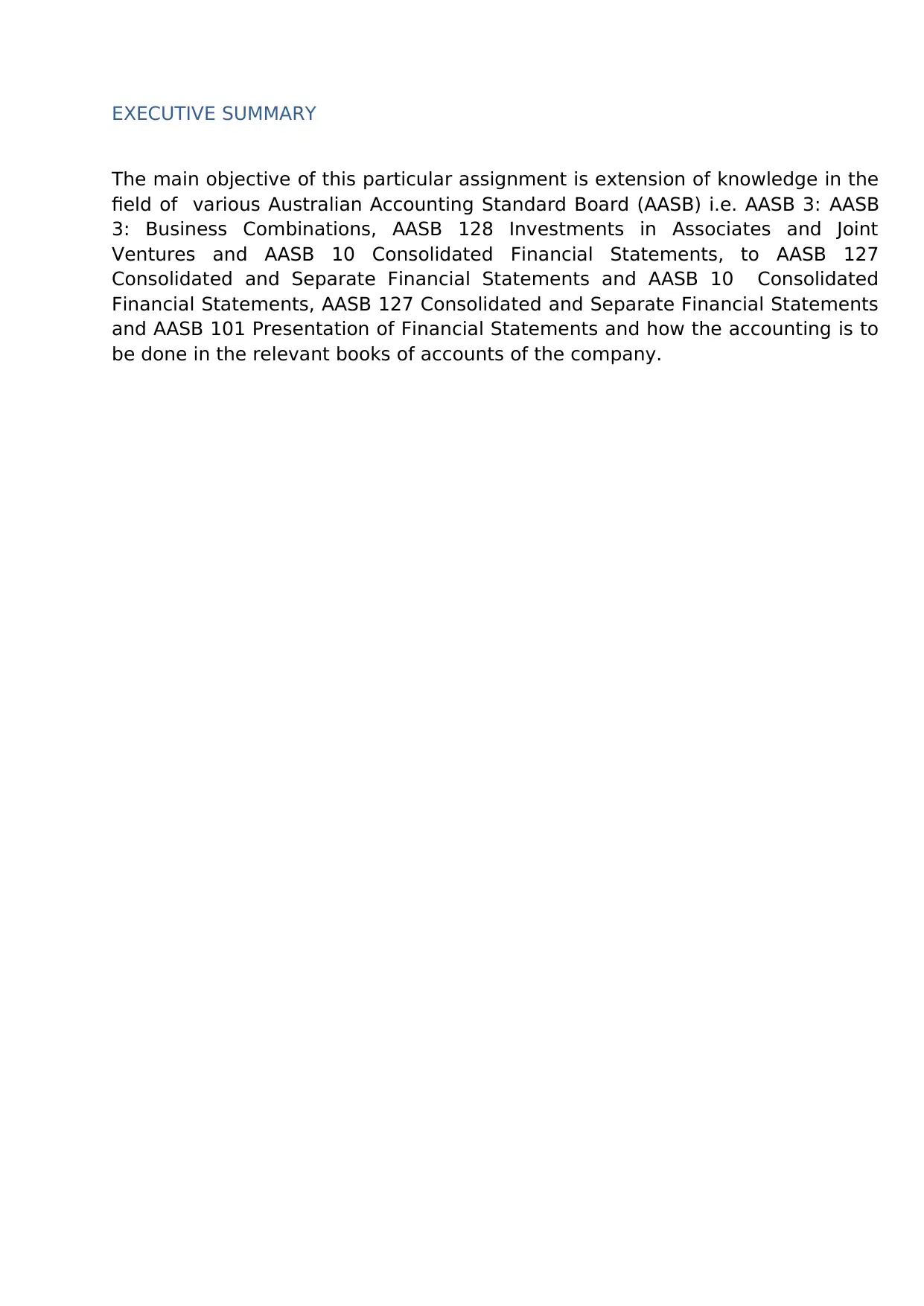
EXECUTIVE SUMMARY
The main objective of this particular assignment is extension of knowledge in the
field of various Australian Accounting Standard Board (AASB) i.e. AASB 3: AASB
3: Business Combinations, AASB 128 Investments in Associates and Joint
Ventures and AASB 10 Consolidated Financial Statements, to AASB 127
Consolidated and Separate Financial Statements and AASB 10 Consolidated
Financial Statements, AASB 127 Consolidated and Separate Financial Statements
and AASB 101 Presentation of Financial Statements and how the accounting is to
be done in the relevant books of accounts of the company.
The main objective of this particular assignment is extension of knowledge in the
field of various Australian Accounting Standard Board (AASB) i.e. AASB 3: AASB
3: Business Combinations, AASB 128 Investments in Associates and Joint
Ventures and AASB 10 Consolidated Financial Statements, to AASB 127
Consolidated and Separate Financial Statements and AASB 10 Consolidated
Financial Statements, AASB 127 Consolidated and Separate Financial Statements
and AASB 101 Presentation of Financial Statements and how the accounting is to
be done in the relevant books of accounts of the company.
Secure Best Marks with AI Grader
Need help grading? Try our AI Grader for instant feedback on your assignments.

Contents
EXECUTIVE SUMMARY..........................................................................................1
INTRODUCTION....................................................................................................3
PART A.................................................................................................................3
PART B.................................................................................................................4
Calculation of consolidated revenue.......................................................................5
Calculation of Consolidated cost of sales................................................................5
Mutual Set off..........................................................................................................5
Valuation of inventory.............................................................................................5
PART C.................................................................................................................5
Calculation of goodwill/bargain purchase...............................................................6
Calculation of profit attributable to NCI..................................................................7
CONCLUSION........................................................................................................7
References..............................................................................................................8
EXECUTIVE SUMMARY..........................................................................................1
INTRODUCTION....................................................................................................3
PART A.................................................................................................................3
PART B.................................................................................................................4
Calculation of consolidated revenue.......................................................................5
Calculation of Consolidated cost of sales................................................................5
Mutual Set off..........................................................................................................5
Valuation of inventory.............................................................................................5
PART C.................................................................................................................5
Calculation of goodwill/bargain purchase...............................................................6
Calculation of profit attributable to NCI..................................................................7
CONCLUSION........................................................................................................7
References..............................................................................................................8
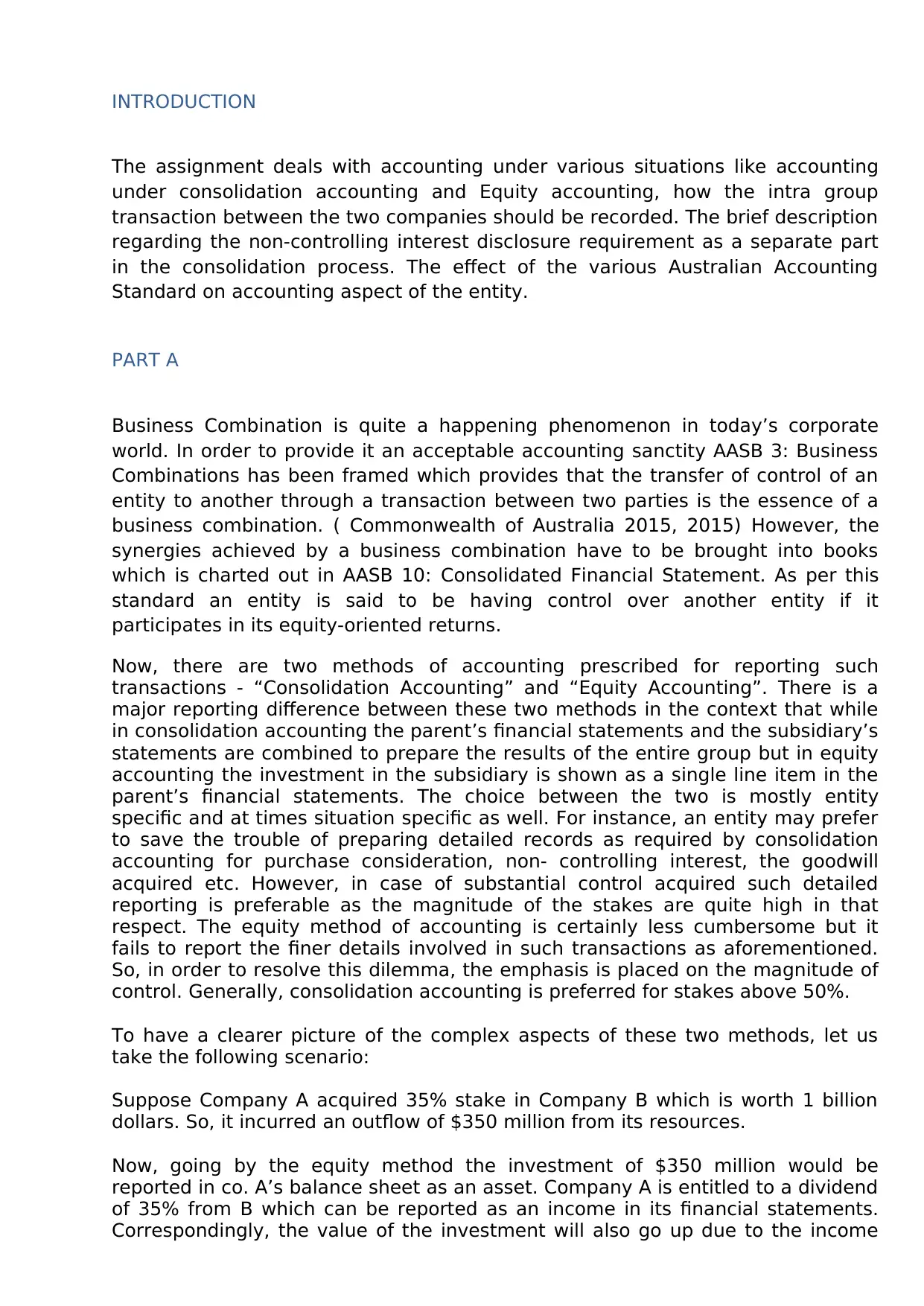
INTRODUCTION
The assignment deals with accounting under various situations like accounting
under consolidation accounting and Equity accounting, how the intra group
transaction between the two companies should be recorded. The brief description
regarding the non-controlling interest disclosure requirement as a separate part
in the consolidation process. The effect of the various Australian Accounting
Standard on accounting aspect of the entity.
PART A
Business Combination is quite a happening phenomenon in today’s corporate
world. In order to provide it an acceptable accounting sanctity AASB 3: Business
Combinations has been framed which provides that the transfer of control of an
entity to another through a transaction between two parties is the essence of a
business combination. ( Commonwealth of Australia 2015, 2015) However, the
synergies achieved by a business combination have to be brought into books
which is charted out in AASB 10: Consolidated Financial Statement. As per this
standard an entity is said to be having control over another entity if it
participates in its equity-oriented returns.
Now, there are two methods of accounting prescribed for reporting such
transactions - “Consolidation Accounting” and “Equity Accounting”. There is a
major reporting difference between these two methods in the context that while
in consolidation accounting the parent’s financial statements and the subsidiary’s
statements are combined to prepare the results of the entire group but in equity
accounting the investment in the subsidiary is shown as a single line item in the
parent’s financial statements. The choice between the two is mostly entity
specific and at times situation specific as well. For instance, an entity may prefer
to save the trouble of preparing detailed records as required by consolidation
accounting for purchase consideration, non- controlling interest, the goodwill
acquired etc. However, in case of substantial control acquired such detailed
reporting is preferable as the magnitude of the stakes are quite high in that
respect. The equity method of accounting is certainly less cumbersome but it
fails to report the finer details involved in such transactions as aforementioned.
So, in order to resolve this dilemma, the emphasis is placed on the magnitude of
control. Generally, consolidation accounting is preferred for stakes above 50%.
To have a clearer picture of the complex aspects of these two methods, let us
take the following scenario:
Suppose Company A acquired 35% stake in Company B which is worth 1 billion
dollars. So, it incurred an outflow of $350 million from its resources.
Now, going by the equity method the investment of $350 million would be
reported in co. A’s balance sheet as an asset. Company A is entitled to a dividend
of 35% from B which can be reported as an income in its financial statements.
Correspondingly, the value of the investment will also go up due to the income
The assignment deals with accounting under various situations like accounting
under consolidation accounting and Equity accounting, how the intra group
transaction between the two companies should be recorded. The brief description
regarding the non-controlling interest disclosure requirement as a separate part
in the consolidation process. The effect of the various Australian Accounting
Standard on accounting aspect of the entity.
PART A
Business Combination is quite a happening phenomenon in today’s corporate
world. In order to provide it an acceptable accounting sanctity AASB 3: Business
Combinations has been framed which provides that the transfer of control of an
entity to another through a transaction between two parties is the essence of a
business combination. ( Commonwealth of Australia 2015, 2015) However, the
synergies achieved by a business combination have to be brought into books
which is charted out in AASB 10: Consolidated Financial Statement. As per this
standard an entity is said to be having control over another entity if it
participates in its equity-oriented returns.
Now, there are two methods of accounting prescribed for reporting such
transactions - “Consolidation Accounting” and “Equity Accounting”. There is a
major reporting difference between these two methods in the context that while
in consolidation accounting the parent’s financial statements and the subsidiary’s
statements are combined to prepare the results of the entire group but in equity
accounting the investment in the subsidiary is shown as a single line item in the
parent’s financial statements. The choice between the two is mostly entity
specific and at times situation specific as well. For instance, an entity may prefer
to save the trouble of preparing detailed records as required by consolidation
accounting for purchase consideration, non- controlling interest, the goodwill
acquired etc. However, in case of substantial control acquired such detailed
reporting is preferable as the magnitude of the stakes are quite high in that
respect. The equity method of accounting is certainly less cumbersome but it
fails to report the finer details involved in such transactions as aforementioned.
So, in order to resolve this dilemma, the emphasis is placed on the magnitude of
control. Generally, consolidation accounting is preferred for stakes above 50%.
To have a clearer picture of the complex aspects of these two methods, let us
take the following scenario:
Suppose Company A acquired 35% stake in Company B which is worth 1 billion
dollars. So, it incurred an outflow of $350 million from its resources.
Now, going by the equity method the investment of $350 million would be
reported in co. A’s balance sheet as an asset. Company A is entitled to a dividend
of 35% from B which can be reported as an income in its financial statements.
Correspondingly, the value of the investment will also go up due to the income
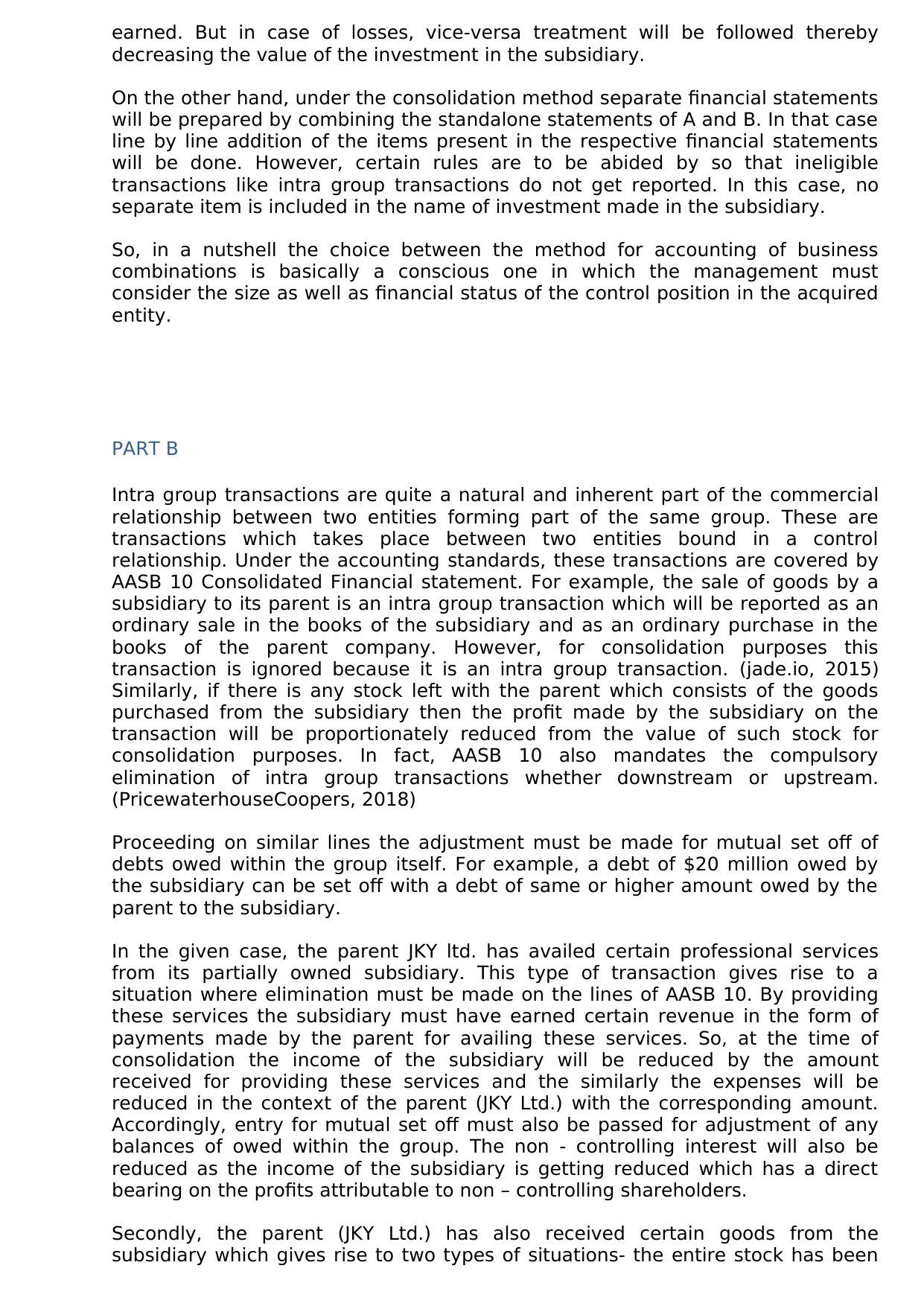
earned. But in case of losses, vice-versa treatment will be followed thereby
decreasing the value of the investment in the subsidiary.
On the other hand, under the consolidation method separate financial statements
will be prepared by combining the standalone statements of A and B. In that case
line by line addition of the items present in the respective financial statements
will be done. However, certain rules are to be abided by so that ineligible
transactions like intra group transactions do not get reported. In this case, no
separate item is included in the name of investment made in the subsidiary.
So, in a nutshell the choice between the method for accounting of business
combinations is basically a conscious one in which the management must
consider the size as well as financial status of the control position in the acquired
entity.
PART B
Intra group transactions are quite a natural and inherent part of the commercial
relationship between two entities forming part of the same group. These are
transactions which takes place between two entities bound in a control
relationship. Under the accounting standards, these transactions are covered by
AASB 10 Consolidated Financial statement. For example, the sale of goods by a
subsidiary to its parent is an intra group transaction which will be reported as an
ordinary sale in the books of the subsidiary and as an ordinary purchase in the
books of the parent company. However, for consolidation purposes this
transaction is ignored because it is an intra group transaction. (jade.io, 2015)
Similarly, if there is any stock left with the parent which consists of the goods
purchased from the subsidiary then the profit made by the subsidiary on the
transaction will be proportionately reduced from the value of such stock for
consolidation purposes. In fact, AASB 10 also mandates the compulsory
elimination of intra group transactions whether downstream or upstream.
(PricewaterhouseCoopers, 2018)
Proceeding on similar lines the adjustment must be made for mutual set off of
debts owed within the group itself. For example, a debt of $20 million owed by
the subsidiary can be set off with a debt of same or higher amount owed by the
parent to the subsidiary.
In the given case, the parent JKY ltd. has availed certain professional services
from its partially owned subsidiary. This type of transaction gives rise to a
situation where elimination must be made on the lines of AASB 10. By providing
these services the subsidiary must have earned certain revenue in the form of
payments made by the parent for availing these services. So, at the time of
consolidation the income of the subsidiary will be reduced by the amount
received for providing these services and the similarly the expenses will be
reduced in the context of the parent (JKY Ltd.) with the corresponding amount.
Accordingly, entry for mutual set off must also be passed for adjustment of any
balances of owed within the group. The non - controlling interest will also be
reduced as the income of the subsidiary is getting reduced which has a direct
bearing on the profits attributable to non – controlling shareholders.
Secondly, the parent (JKY Ltd.) has also received certain goods from the
subsidiary which gives rise to two types of situations- the entire stock has been
decreasing the value of the investment in the subsidiary.
On the other hand, under the consolidation method separate financial statements
will be prepared by combining the standalone statements of A and B. In that case
line by line addition of the items present in the respective financial statements
will be done. However, certain rules are to be abided by so that ineligible
transactions like intra group transactions do not get reported. In this case, no
separate item is included in the name of investment made in the subsidiary.
So, in a nutshell the choice between the method for accounting of business
combinations is basically a conscious one in which the management must
consider the size as well as financial status of the control position in the acquired
entity.
PART B
Intra group transactions are quite a natural and inherent part of the commercial
relationship between two entities forming part of the same group. These are
transactions which takes place between two entities bound in a control
relationship. Under the accounting standards, these transactions are covered by
AASB 10 Consolidated Financial statement. For example, the sale of goods by a
subsidiary to its parent is an intra group transaction which will be reported as an
ordinary sale in the books of the subsidiary and as an ordinary purchase in the
books of the parent company. However, for consolidation purposes this
transaction is ignored because it is an intra group transaction. (jade.io, 2015)
Similarly, if there is any stock left with the parent which consists of the goods
purchased from the subsidiary then the profit made by the subsidiary on the
transaction will be proportionately reduced from the value of such stock for
consolidation purposes. In fact, AASB 10 also mandates the compulsory
elimination of intra group transactions whether downstream or upstream.
(PricewaterhouseCoopers, 2018)
Proceeding on similar lines the adjustment must be made for mutual set off of
debts owed within the group itself. For example, a debt of $20 million owed by
the subsidiary can be set off with a debt of same or higher amount owed by the
parent to the subsidiary.
In the given case, the parent JKY ltd. has availed certain professional services
from its partially owned subsidiary. This type of transaction gives rise to a
situation where elimination must be made on the lines of AASB 10. By providing
these services the subsidiary must have earned certain revenue in the form of
payments made by the parent for availing these services. So, at the time of
consolidation the income of the subsidiary will be reduced by the amount
received for providing these services and the similarly the expenses will be
reduced in the context of the parent (JKY Ltd.) with the corresponding amount.
Accordingly, entry for mutual set off must also be passed for adjustment of any
balances of owed within the group. The non - controlling interest will also be
reduced as the income of the subsidiary is getting reduced which has a direct
bearing on the profits attributable to non – controlling shareholders.
Secondly, the parent (JKY Ltd.) has also received certain goods from the
subsidiary which gives rise to two types of situations- the entire stock has been
Secure Best Marks with AI Grader
Need help grading? Try our AI Grader for instant feedback on your assignments.
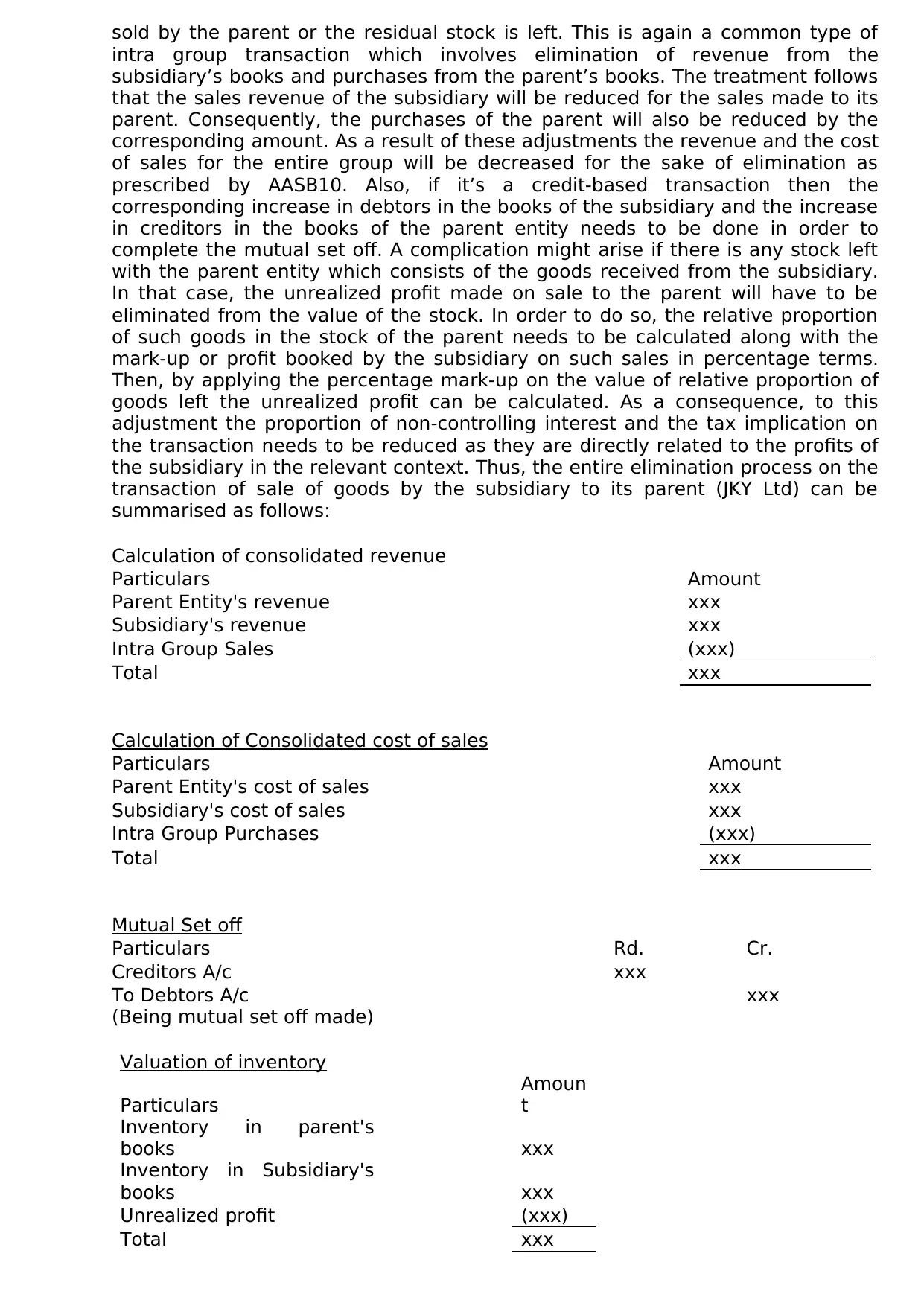
sold by the parent or the residual stock is left. This is again a common type of
intra group transaction which involves elimination of revenue from the
subsidiary’s books and purchases from the parent’s books. The treatment follows
that the sales revenue of the subsidiary will be reduced for the sales made to its
parent. Consequently, the purchases of the parent will also be reduced by the
corresponding amount. As a result of these adjustments the revenue and the cost
of sales for the entire group will be decreased for the sake of elimination as
prescribed by AASB10. Also, if it’s a credit-based transaction then the
corresponding increase in debtors in the books of the subsidiary and the increase
in creditors in the books of the parent entity needs to be done in order to
complete the mutual set off. A complication might arise if there is any stock left
with the parent entity which consists of the goods received from the subsidiary.
In that case, the unrealized profit made on sale to the parent will have to be
eliminated from the value of the stock. In order to do so, the relative proportion
of such goods in the stock of the parent needs to be calculated along with the
mark-up or profit booked by the subsidiary on such sales in percentage terms.
Then, by applying the percentage mark-up on the value of relative proportion of
goods left the unrealized profit can be calculated. As a consequence, to this
adjustment the proportion of non-controlling interest and the tax implication on
the transaction needs to be reduced as they are directly related to the profits of
the subsidiary in the relevant context. Thus, the entire elimination process on the
transaction of sale of goods by the subsidiary to its parent (JKY Ltd) can be
summarised as follows:
Calculation of consolidated revenue
Particulars Amount
Parent Entity's revenue xxx
Subsidiary's revenue xxx
Intra Group Sales (xxx)
Total xxx
Calculation of Consolidated cost of sales
Particulars Amount
Parent Entity's cost of sales xxx
Subsidiary's cost of sales xxx
Intra Group Purchases (xxx)
Total xxx
Mutual Set off
Particulars Rd. Cr.
Creditors A/c xxx
To Debtors A/c xxx
(Being mutual set off made)
Valuation of inventory
Particulars
Amoun
t
Inventory in parent's
books xxx
Inventory in Subsidiary's
books xxx
Unrealized profit (xxx)
Total xxx
intra group transaction which involves elimination of revenue from the
subsidiary’s books and purchases from the parent’s books. The treatment follows
that the sales revenue of the subsidiary will be reduced for the sales made to its
parent. Consequently, the purchases of the parent will also be reduced by the
corresponding amount. As a result of these adjustments the revenue and the cost
of sales for the entire group will be decreased for the sake of elimination as
prescribed by AASB10. Also, if it’s a credit-based transaction then the
corresponding increase in debtors in the books of the subsidiary and the increase
in creditors in the books of the parent entity needs to be done in order to
complete the mutual set off. A complication might arise if there is any stock left
with the parent entity which consists of the goods received from the subsidiary.
In that case, the unrealized profit made on sale to the parent will have to be
eliminated from the value of the stock. In order to do so, the relative proportion
of such goods in the stock of the parent needs to be calculated along with the
mark-up or profit booked by the subsidiary on such sales in percentage terms.
Then, by applying the percentage mark-up on the value of relative proportion of
goods left the unrealized profit can be calculated. As a consequence, to this
adjustment the proportion of non-controlling interest and the tax implication on
the transaction needs to be reduced as they are directly related to the profits of
the subsidiary in the relevant context. Thus, the entire elimination process on the
transaction of sale of goods by the subsidiary to its parent (JKY Ltd) can be
summarised as follows:
Calculation of consolidated revenue
Particulars Amount
Parent Entity's revenue xxx
Subsidiary's revenue xxx
Intra Group Sales (xxx)
Total xxx
Calculation of Consolidated cost of sales
Particulars Amount
Parent Entity's cost of sales xxx
Subsidiary's cost of sales xxx
Intra Group Purchases (xxx)
Total xxx
Mutual Set off
Particulars Rd. Cr.
Creditors A/c xxx
To Debtors A/c xxx
(Being mutual set off made)
Valuation of inventory
Particulars
Amoun
t
Inventory in parent's
books xxx
Inventory in Subsidiary's
books xxx
Unrealized profit (xxx)
Total xxx
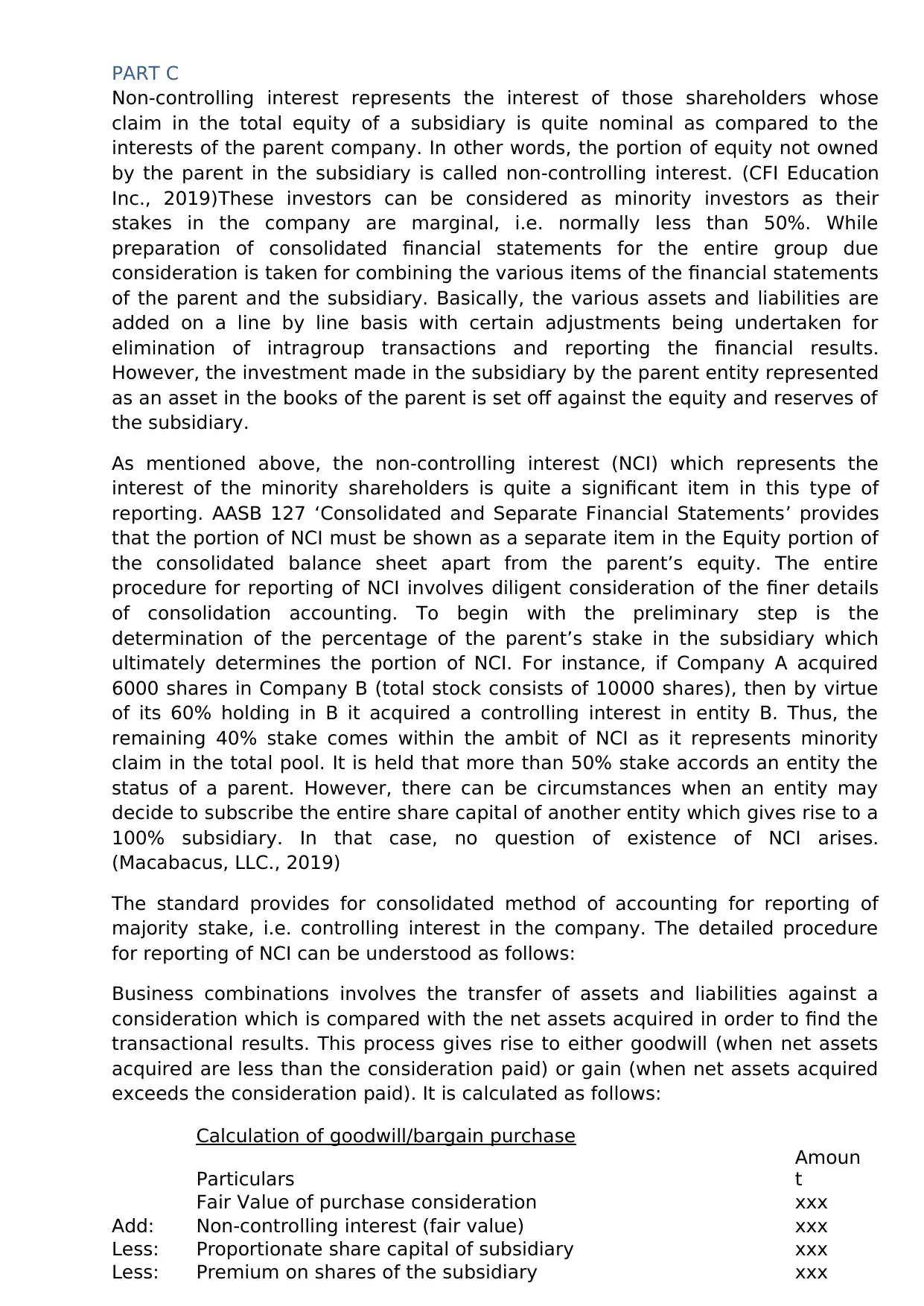
PART C
Non-controlling interest represents the interest of those shareholders whose
claim in the total equity of a subsidiary is quite nominal as compared to the
interests of the parent company. In other words, the portion of equity not owned
by the parent in the subsidiary is called non-controlling interest. (CFI Education
Inc., 2019)These investors can be considered as minority investors as their
stakes in the company are marginal, i.e. normally less than 50%. While
preparation of consolidated financial statements for the entire group due
consideration is taken for combining the various items of the financial statements
of the parent and the subsidiary. Basically, the various assets and liabilities are
added on a line by line basis with certain adjustments being undertaken for
elimination of intragroup transactions and reporting the financial results.
However, the investment made in the subsidiary by the parent entity represented
as an asset in the books of the parent is set off against the equity and reserves of
the subsidiary.
As mentioned above, the non-controlling interest (NCI) which represents the
interest of the minority shareholders is quite a significant item in this type of
reporting. AASB 127 ‘Consolidated and Separate Financial Statements’ provides
that the portion of NCI must be shown as a separate item in the Equity portion of
the consolidated balance sheet apart from the parent’s equity. The entire
procedure for reporting of NCI involves diligent consideration of the finer details
of consolidation accounting. To begin with the preliminary step is the
determination of the percentage of the parent’s stake in the subsidiary which
ultimately determines the portion of NCI. For instance, if Company A acquired
6000 shares in Company B (total stock consists of 10000 shares), then by virtue
of its 60% holding in B it acquired a controlling interest in entity B. Thus, the
remaining 40% stake comes within the ambit of NCI as it represents minority
claim in the total pool. It is held that more than 50% stake accords an entity the
status of a parent. However, there can be circumstances when an entity may
decide to subscribe the entire share capital of another entity which gives rise to a
100% subsidiary. In that case, no question of existence of NCI arises.
(Macabacus, LLC., 2019)
The standard provides for consolidated method of accounting for reporting of
majority stake, i.e. controlling interest in the company. The detailed procedure
for reporting of NCI can be understood as follows:
Business combinations involves the transfer of assets and liabilities against a
consideration which is compared with the net assets acquired in order to find the
transactional results. This process gives rise to either goodwill (when net assets
acquired are less than the consideration paid) or gain (when net assets acquired
exceeds the consideration paid). It is calculated as follows:
Calculation of goodwill/bargain purchase
Particulars
Amoun
t
Fair Value of purchase consideration xxx
Add: Non-controlling interest (fair value) xxx
Less: Proportionate share capital of subsidiary xxx
Less: Premium on shares of the subsidiary xxx
Non-controlling interest represents the interest of those shareholders whose
claim in the total equity of a subsidiary is quite nominal as compared to the
interests of the parent company. In other words, the portion of equity not owned
by the parent in the subsidiary is called non-controlling interest. (CFI Education
Inc., 2019)These investors can be considered as minority investors as their
stakes in the company are marginal, i.e. normally less than 50%. While
preparation of consolidated financial statements for the entire group due
consideration is taken for combining the various items of the financial statements
of the parent and the subsidiary. Basically, the various assets and liabilities are
added on a line by line basis with certain adjustments being undertaken for
elimination of intragroup transactions and reporting the financial results.
However, the investment made in the subsidiary by the parent entity represented
as an asset in the books of the parent is set off against the equity and reserves of
the subsidiary.
As mentioned above, the non-controlling interest (NCI) which represents the
interest of the minority shareholders is quite a significant item in this type of
reporting. AASB 127 ‘Consolidated and Separate Financial Statements’ provides
that the portion of NCI must be shown as a separate item in the Equity portion of
the consolidated balance sheet apart from the parent’s equity. The entire
procedure for reporting of NCI involves diligent consideration of the finer details
of consolidation accounting. To begin with the preliminary step is the
determination of the percentage of the parent’s stake in the subsidiary which
ultimately determines the portion of NCI. For instance, if Company A acquired
6000 shares in Company B (total stock consists of 10000 shares), then by virtue
of its 60% holding in B it acquired a controlling interest in entity B. Thus, the
remaining 40% stake comes within the ambit of NCI as it represents minority
claim in the total pool. It is held that more than 50% stake accords an entity the
status of a parent. However, there can be circumstances when an entity may
decide to subscribe the entire share capital of another entity which gives rise to a
100% subsidiary. In that case, no question of existence of NCI arises.
(Macabacus, LLC., 2019)
The standard provides for consolidated method of accounting for reporting of
majority stake, i.e. controlling interest in the company. The detailed procedure
for reporting of NCI can be understood as follows:
Business combinations involves the transfer of assets and liabilities against a
consideration which is compared with the net assets acquired in order to find the
transactional results. This process gives rise to either goodwill (when net assets
acquired are less than the consideration paid) or gain (when net assets acquired
exceeds the consideration paid). It is calculated as follows:
Calculation of goodwill/bargain purchase
Particulars
Amoun
t
Fair Value of purchase consideration xxx
Add: Non-controlling interest (fair value) xxx
Less: Proportionate share capital of subsidiary xxx
Less: Premium on shares of the subsidiary xxx
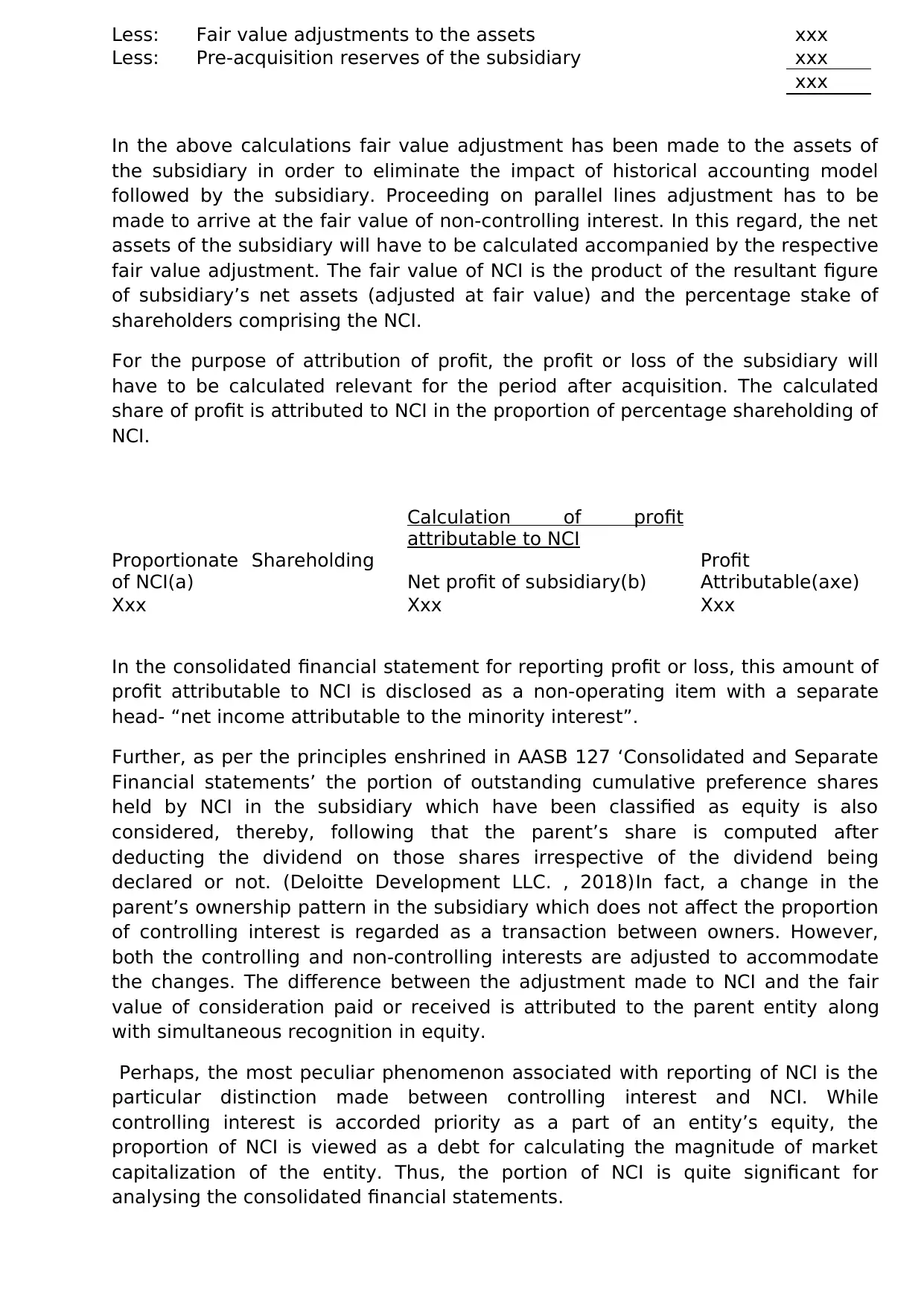
Less: Fair value adjustments to the assets xxx
Less: Pre-acquisition reserves of the subsidiary xxx
xxx
In the above calculations fair value adjustment has been made to the assets of
the subsidiary in order to eliminate the impact of historical accounting model
followed by the subsidiary. Proceeding on parallel lines adjustment has to be
made to arrive at the fair value of non-controlling interest. In this regard, the net
assets of the subsidiary will have to be calculated accompanied by the respective
fair value adjustment. The fair value of NCI is the product of the resultant figure
of subsidiary’s net assets (adjusted at fair value) and the percentage stake of
shareholders comprising the NCI.
For the purpose of attribution of profit, the profit or loss of the subsidiary will
have to be calculated relevant for the period after acquisition. The calculated
share of profit is attributed to NCI in the proportion of percentage shareholding of
NCI.
Calculation of profit
attributable to NCI
Proportionate Shareholding
of NCI(a) Net profit of subsidiary(b)
Profit
Attributable(axe)
Xxx Xxx Xxx
In the consolidated financial statement for reporting profit or loss, this amount of
profit attributable to NCI is disclosed as a non-operating item with a separate
head- “net income attributable to the minority interest”.
Further, as per the principles enshrined in AASB 127 ‘Consolidated and Separate
Financial statements’ the portion of outstanding cumulative preference shares
held by NCI in the subsidiary which have been classified as equity is also
considered, thereby, following that the parent’s share is computed after
deducting the dividend on those shares irrespective of the dividend being
declared or not. (Deloitte Development LLC. , 2018)In fact, a change in the
parent’s ownership pattern in the subsidiary which does not affect the proportion
of controlling interest is regarded as a transaction between owners. However,
both the controlling and non-controlling interests are adjusted to accommodate
the changes. The difference between the adjustment made to NCI and the fair
value of consideration paid or received is attributed to the parent entity along
with simultaneous recognition in equity.
Perhaps, the most peculiar phenomenon associated with reporting of NCI is the
particular distinction made between controlling interest and NCI. While
controlling interest is accorded priority as a part of an entity’s equity, the
proportion of NCI is viewed as a debt for calculating the magnitude of market
capitalization of the entity. Thus, the portion of NCI is quite significant for
analysing the consolidated financial statements.
Less: Pre-acquisition reserves of the subsidiary xxx
xxx
In the above calculations fair value adjustment has been made to the assets of
the subsidiary in order to eliminate the impact of historical accounting model
followed by the subsidiary. Proceeding on parallel lines adjustment has to be
made to arrive at the fair value of non-controlling interest. In this regard, the net
assets of the subsidiary will have to be calculated accompanied by the respective
fair value adjustment. The fair value of NCI is the product of the resultant figure
of subsidiary’s net assets (adjusted at fair value) and the percentage stake of
shareholders comprising the NCI.
For the purpose of attribution of profit, the profit or loss of the subsidiary will
have to be calculated relevant for the period after acquisition. The calculated
share of profit is attributed to NCI in the proportion of percentage shareholding of
NCI.
Calculation of profit
attributable to NCI
Proportionate Shareholding
of NCI(a) Net profit of subsidiary(b)
Profit
Attributable(axe)
Xxx Xxx Xxx
In the consolidated financial statement for reporting profit or loss, this amount of
profit attributable to NCI is disclosed as a non-operating item with a separate
head- “net income attributable to the minority interest”.
Further, as per the principles enshrined in AASB 127 ‘Consolidated and Separate
Financial statements’ the portion of outstanding cumulative preference shares
held by NCI in the subsidiary which have been classified as equity is also
considered, thereby, following that the parent’s share is computed after
deducting the dividend on those shares irrespective of the dividend being
declared or not. (Deloitte Development LLC. , 2018)In fact, a change in the
parent’s ownership pattern in the subsidiary which does not affect the proportion
of controlling interest is regarded as a transaction between owners. However,
both the controlling and non-controlling interests are adjusted to accommodate
the changes. The difference between the adjustment made to NCI and the fair
value of consideration paid or received is attributed to the parent entity along
with simultaneous recognition in equity.
Perhaps, the most peculiar phenomenon associated with reporting of NCI is the
particular distinction made between controlling interest and NCI. While
controlling interest is accorded priority as a part of an entity’s equity, the
proportion of NCI is viewed as a debt for calculating the magnitude of market
capitalization of the entity. Thus, the portion of NCI is quite significant for
analysing the consolidated financial statements.
Paraphrase This Document
Need a fresh take? Get an instant paraphrase of this document with our AI Paraphraser
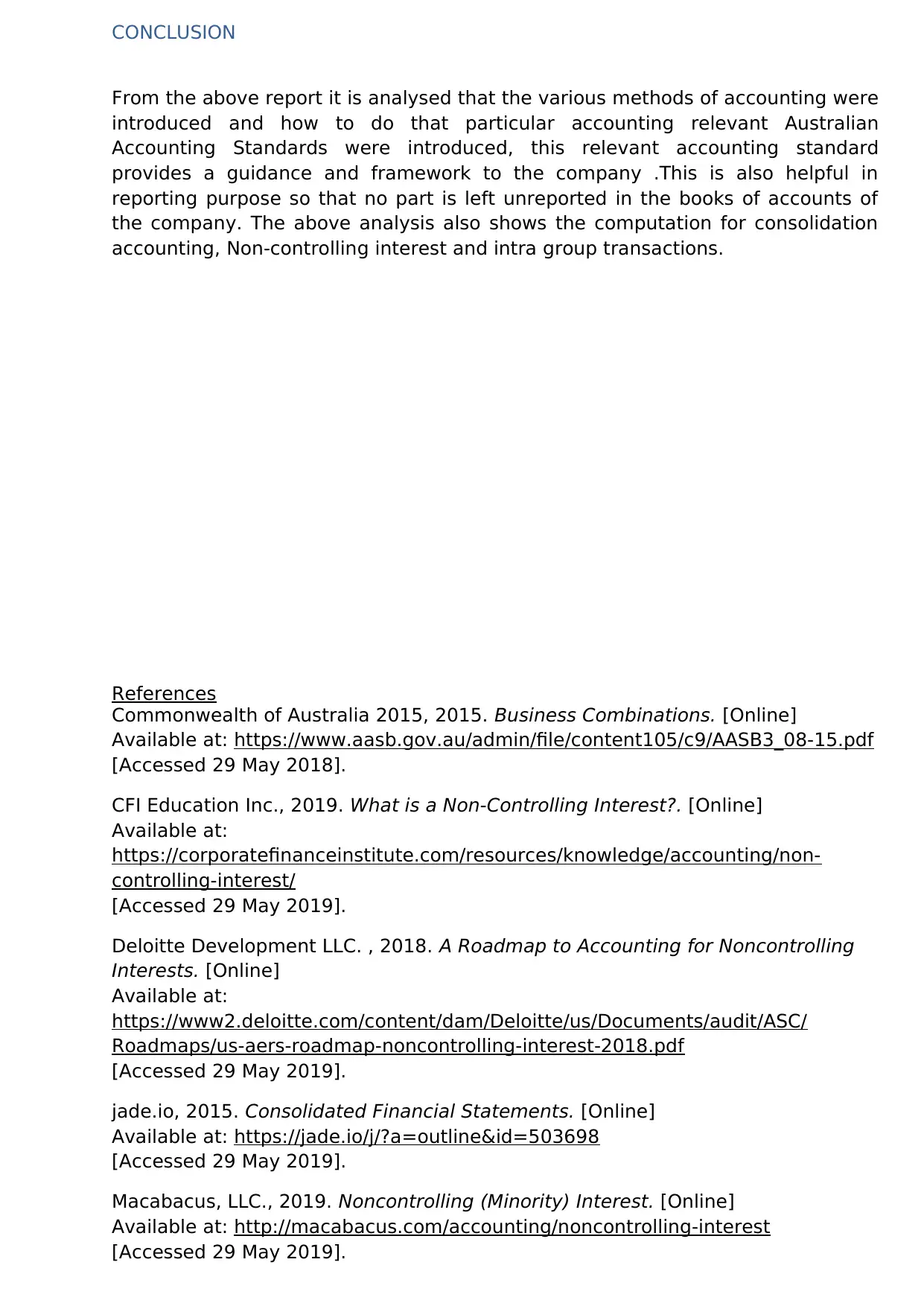
CONCLUSION
From the above report it is analysed that the various methods of accounting were
introduced and how to do that particular accounting relevant Australian
Accounting Standards were introduced, this relevant accounting standard
provides a guidance and framework to the company .This is also helpful in
reporting purpose so that no part is left unreported in the books of accounts of
the company. The above analysis also shows the computation for consolidation
accounting, Non-controlling interest and intra group transactions.
References
Commonwealth of Australia 2015, 2015. Business Combinations. [Online]
Available at: https://www.aasb.gov.au/admin/file/content105/c9/AASB3_08-15.pdf
[Accessed 29 May 2018].
CFI Education Inc., 2019. What is a Non-Controlling Interest?. [Online]
Available at:
https://corporatefinanceinstitute.com/resources/knowledge/accounting/non-
controlling-interest/
[Accessed 29 May 2019].
Deloitte Development LLC. , 2018. A Roadmap to Accounting for Noncontrolling
Interests. [Online]
Available at:
https://www2.deloitte.com/content/dam/Deloitte/us/Documents/audit/ASC/
Roadmaps/us-aers-roadmap-noncontrolling-interest-2018.pdf
[Accessed 29 May 2019].
jade.io, 2015. Consolidated Financial Statements. [Online]
Available at: https://jade.io/j/?a=outline&id=503698
[Accessed 29 May 2019].
Macabacus, LLC., 2019. Noncontrolling (Minority) Interest. [Online]
Available at: http://macabacus.com/accounting/noncontrolling-interest
[Accessed 29 May 2019].
From the above report it is analysed that the various methods of accounting were
introduced and how to do that particular accounting relevant Australian
Accounting Standards were introduced, this relevant accounting standard
provides a guidance and framework to the company .This is also helpful in
reporting purpose so that no part is left unreported in the books of accounts of
the company. The above analysis also shows the computation for consolidation
accounting, Non-controlling interest and intra group transactions.
References
Commonwealth of Australia 2015, 2015. Business Combinations. [Online]
Available at: https://www.aasb.gov.au/admin/file/content105/c9/AASB3_08-15.pdf
[Accessed 29 May 2018].
CFI Education Inc., 2019. What is a Non-Controlling Interest?. [Online]
Available at:
https://corporatefinanceinstitute.com/resources/knowledge/accounting/non-
controlling-interest/
[Accessed 29 May 2019].
Deloitte Development LLC. , 2018. A Roadmap to Accounting for Noncontrolling
Interests. [Online]
Available at:
https://www2.deloitte.com/content/dam/Deloitte/us/Documents/audit/ASC/
Roadmaps/us-aers-roadmap-noncontrolling-interest-2018.pdf
[Accessed 29 May 2019].
jade.io, 2015. Consolidated Financial Statements. [Online]
Available at: https://jade.io/j/?a=outline&id=503698
[Accessed 29 May 2019].
Macabacus, LLC., 2019. Noncontrolling (Minority) Interest. [Online]
Available at: http://macabacus.com/accounting/noncontrolling-interest
[Accessed 29 May 2019].

PricewaterhouseCoopers, 2018. Consolidation. [Online]
Available at: https://www.pwc.com.au/assurance/ifrs/assets/consolidation-are-
you-one-big-happy-family.pdf
[Accessed 29 May 2019].
Available at: https://www.pwc.com.au/assurance/ifrs/assets/consolidation-are-
you-one-big-happy-family.pdf
[Accessed 29 May 2019].
1 out of 9
Related Documents
Your All-in-One AI-Powered Toolkit for Academic Success.
+13062052269
info@desklib.com
Available 24*7 on WhatsApp / Email
![[object Object]](/_next/static/media/star-bottom.7253800d.svg)
Unlock your academic potential
© 2024 | Zucol Services PVT LTD | All rights reserved.





